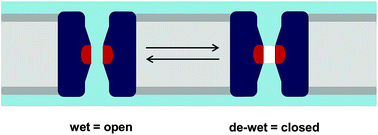当前位置:
X-MOL 学术
›
Faraday Discuss.
›
论文详情
Our official English website, www.x-mol.net, welcomes your feedback! (Note: you will need to create a separate account there.)
Water and hydrophobic gates in ion channels and nanopores
Faraday Discussions ( IF 3.4 ) Pub Date : 2018-04-16 , DOI: 10.1039/c8fd00013a Shanlin Rao 1, 2, 3 , Charlotte I. Lynch 1, 2, 3 , Gianni Klesse 1, 2, 3, 4, 5 , Georgia E. Oakley 1, 2, 3 , Phillip J. Stansfeld 1, 2, 3 , Stephen J. Tucker 2, 3, 4, 5 , Mark S. P. Sansom 1, 2, 3
Faraday Discussions ( IF 3.4 ) Pub Date : 2018-04-16 , DOI: 10.1039/c8fd00013a Shanlin Rao 1, 2, 3 , Charlotte I. Lynch 1, 2, 3 , Gianni Klesse 1, 2, 3, 4, 5 , Georgia E. Oakley 1, 2, 3 , Phillip J. Stansfeld 1, 2, 3 , Stephen J. Tucker 2, 3, 4, 5 , Mark S. P. Sansom 1, 2, 3
Affiliation

|
Ion channel proteins form nanopores in biological membranes which allow the passage of ions and water molecules. Hydrophobic constrictions in such pores can form gates, i.e. energetic barriers to water and ion permeation. Molecular dynamics simulations of water in ion channels may be used to assess whether a hydrophobic gate is closed (i.e. impermeable to ions) or open. If there is an energetic barrier to water permeation then it is likely that a gate will also be impermeable to ions. Simulations of water behaviour have been used to probe hydrophobic gates in two recently reported ion channel structures: BEST1 and TMEM175. In each of these channels a narrow region is formed by three consecutive rings of hydrophobic sidechains and in both cases such analysis demonstrates that the crystal structures correspond to a closed state of the channel. In silico mutations of BEST1 have also been used to explore the effect of changes in the hydrophobicity of the gating constriction, demonstrating that substitution of hydrophobic sidechains with more polar sidechains results in an open gate which allows water permeation. A possible open state of the TMEM175 channel was modelled by the in silico expansion of the hydrophobic gate resulting in the wetting of the pore and free permeation of potassium ions through the channel. Finally, a preliminary study suggests that a hydrophobic gate motif can be transplanted in silico from the BEST1 channel into a simple β-barrel pore template. Overall, these results suggest that simulations of the behaviour of water in hydrophobic gates can reveal important design principles for the engineering of gates in novel biomimetic nanopores.
中文翻译:

离子通道和纳米孔中的水和疏水门
离子通道蛋白在生物膜中形成纳米孔,从而允许离子和水分子通过。此类孔中的疏水收缩可形成门,即对水和离子渗透的高能屏障。离子通道中水的分子动力学模拟可用于评估疏水门是否关闭(即离子不可透过)或开放。如果对水的渗透存在能量屏障,则门很可能也不能渗透离子。水行为的模拟已被用来探测两个最近报道的离子通道结构中的疏水门:BEST1和TMEM175。在这些通道的每一个中,疏水性侧链的三个连续环形成一个狭窄的区域,在两种情况下,这种分析表明晶体结构对应于通道的闭合状态。在计算机上BEST1的突变也已用于探索门控缩窄疏水性变化的影响,表明疏水侧链被更多极性侧链取代会导致开放的闸门,从而允许水渗透。TMEM175通道可能的开放状态是通过疏水门的计算机内膨胀模拟的,从而导致孔变湿和钾离子通过通道的自由渗透。最后,一项初步研究表明,疏水门基序可以通过计算机移植从BEST1通道变成简单的β-桶孔模板。总体而言,这些结果表明,疏水门中水行为的模拟可以揭示新型仿生纳米孔中门工程的重要设计原理。
更新日期:2018-09-28
中文翻译:

离子通道和纳米孔中的水和疏水门
离子通道蛋白在生物膜中形成纳米孔,从而允许离子和水分子通过。此类孔中的疏水收缩可形成门,即对水和离子渗透的高能屏障。离子通道中水的分子动力学模拟可用于评估疏水门是否关闭(即离子不可透过)或开放。如果对水的渗透存在能量屏障,则门很可能也不能渗透离子。水行为的模拟已被用来探测两个最近报道的离子通道结构中的疏水门:BEST1和TMEM175。在这些通道的每一个中,疏水性侧链的三个连续环形成一个狭窄的区域,在两种情况下,这种分析表明晶体结构对应于通道的闭合状态。在计算机上BEST1的突变也已用于探索门控缩窄疏水性变化的影响,表明疏水侧链被更多极性侧链取代会导致开放的闸门,从而允许水渗透。TMEM175通道可能的开放状态是通过疏水门的计算机内膨胀模拟的,从而导致孔变湿和钾离子通过通道的自由渗透。最后,一项初步研究表明,疏水门基序可以通过计算机移植从BEST1通道变成简单的β-桶孔模板。总体而言,这些结果表明,疏水门中水行为的模拟可以揭示新型仿生纳米孔中门工程的重要设计原理。



























 京公网安备 11010802027423号
京公网安备 11010802027423号